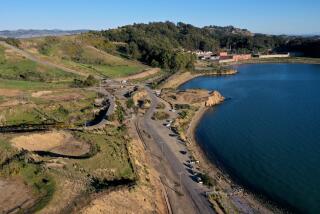‘A diamond’ in Long Beach
Riding her bike throughout Long Beach, Carol Hillis became a frequent sight for residents. She was a local teacher for 25 years, subbing the last six, and she was an avid runner and cyclist. She would cycle along the San Gabriel River, through her Long Beach neighborhood and at El Dorado East Regional Park.
When she died of cancer this summer at 61, nearly 700 people came to El Dorado -- where Hillis had spent so much of her time -- to celebrate her life.
The Hillises chose El Dorado park because it was central to their community and it was accommodating.
“She loved the park,” her husband, Fred Hillis, said.
Last month, El Dorado East Regional Park celebrated its 40th anniversary with a party that included a fundraiser for the park, along with a live band and 150 residents and employees celebrating the park’s history.
Each month, 10,000 to 12,000 vehicles enter the 400-acre park, some coming from as far as San Diego to use the facilities.
One of the features that draws Southern California residents is the glider field, where nearly 50 to 60 model-aircraft builders come each day to fly their planes and helicopters, according to Jack Deaton, the park’s supervisor.
The glider field is also the meeting site of the El Dorado Silent Flyers, a group of about 60 model-airplane enthusiasts who gather once a month at the park.
“It’s an amazing park,” said Bill Sorensen, 65, secretary of the Silent Flyers. “We’re very lucky to have this big space here.”
Some parkgoers are also lured by the archery range -- used in the 1984 Olympic Games -- where free archery classes are given each weekend to children and adults. Nearly 30 archers come each day to practice their shooting skills.
On the weekends paddle-boat rentals are available, and bicyclists and Rollerbladers frequently have racing events on the 4.5 miles of winding paved paths.
Each April, nearly 20,000 people from the Cambodian community in Long Beach celebrate the Cambodian New Year in the densely wooded Golden Grove region of the park.
There are also three fully stocked lakes at El Dorado, filled by the state Department of Fish and Game with bass, bluegill, catfish and trout.
One of the regular anglers is Brett Randell, 48, who has been coming to the park for 36 years.
“Everyone’s friendly,” Randell said. “Park rangers stay and talk to you. It’s fishermen-friendly.”
Randell first came to El Dorado to fish with his brother when he was about 7 years old. Never living more than a mile away from the park, Randell continued to visit it into adulthood, coming three or four times a week and often bringing the mother of a fellow fisherman, Mary Rubideaux, for company.
“It’s the best place in town,” Rubideaux, who is “past 80,” said. “They can take downtown and do whatever they want with it. This is my idea of relaxation. It’s a diamond for the city of Long Beach.”
Along with the diverse fish population is a thriving bird community. Snowy and black egrets; red-tailed, red-shouldered and Cooper’s hawks; kestrels; turkey vultures; various songbirds and a sizable Canada goose population have all made the park home, according to park ranger Dave Sterling.
An immature bald eagle also briefly made an appearance at the park last December, drawing bird photographers from around the western United States.
Coyotes, opossums, skunks and raccoons also regularly visit.
“We did have a grizzly bear here last week, but that was for ‘CSI: Miami,’ ” Supervising Park Ranger William Greco said, referring to an animal brought in for filming.
Across the street from the park is the 100-acre El Dorado Nature Center, which is more dense with trees, ponds and streams and has a museum devoted to native plant and animal species.
The museum offers classes for adults on gardening with native plants, and nature and “Super Science” classes for children.
The nature center is dotted with eucalyptus, oak groves, coastal sage scrub and Brazilian pepper trees, according to Erin Kellogg, a park naturalist for the center.
Although the nature center was initially planted haphazardly, with native and nonnative plants growing side by side, there is currently an effort to use only plants that are indigenous to the area once the foreign plants die out, Kellogg said.
Kellogg began working at the center immediately after graduating from Cal State Long Beach with a degree in psychology and fell in love with it, turning a first job into a 10-year career.
“Some people walk into work and smell coffee. I come in and sometimes I smell skunk. I love it,” Kellogg said.
More to Read
Sign up for Essential California
The most important California stories and recommendations in your inbox every morning.
You may occasionally receive promotional content from the Los Angeles Times.









